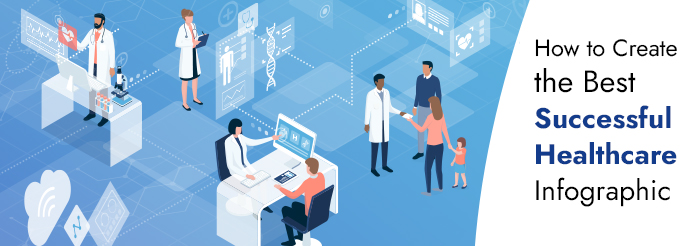How to Create the Best Successful Healthcare Infographic
Posted on
We humans are visual creatures. What we see typically has a far greater impact on us than what we read or say. That’s why successful, effective infographics are so important for reaching your patient prospects in healthcare marketing.
Too often, healthcare information is more detailed and complicated than it needs to be for an average reader. Doctors may ask if the data presented in an infographic is based on primary or secondary research. They may ask whether the study was double-blind or placebo-controlled, and if it includes a broad section of the population or if there a sampling bias. Have the results of the study presented in an infographic been peer-reviewed?
An effective content marketing strategy for infographic creation is to cut through that kind of medical jargon and analysis and make the information easy to understand for any individual who does not have an MD or PhD after their name.
Why use infographics at all?
Infographics have become one of the most effective ways to share information that’s easy to understand and remember. An infographic’s purpose is to show rather than tell. Infographics have the unique ability to reduce complex facts and statistics into attractive, easy-to-read, easy-to-share information packages.

Effective infographics deliver benefits to your content marketing strategy
Did you know that infographics are up to 30 times more likely to be read than full-length articles or blog posts? Did you know that infographics can drive up to 12% more web traffic? It’s true, and infographics can help your practice connect to a wider audience.
Infographics can be shared across many channels, including blogs, websites and social media platforms. They present important information in a way that’s easy to understand. In addition, research shows that people remember 65% of what they see in a visual presentation.
What makes infographics successful?
Before you or your healthcare marketing partner begins your design process, consider the following infographic tips and tricks and take some inspiration from a few of the most successful healthcare marketing infographics such as those created by the CDC, Johns Hopkins University (infographic on stress) the Cleveland Clinic (infographics on health and prevention) and UVA Health (infographic about quitting smoking).
Infographic Design Considerations
Here are some infographic tips and tricks for more effective design:
1 Infographics always put your audience first
First and foremost, consider what topics your readers and followers are interested in. What is causing them pain? What kind of information are they most likely to share within their social circles? Topics focused on disease prevention and wellness are usually great places to start for many healthcare practices.

2 Infographics simplify topics and stay on point
The best infographics give readers a snapshot of information. They always stay on point and focus on just one key issue, which they should present thoroughly and concisely. A good example is an infographic from the Centers for Disease Control and Prevention (CDC) that explains how to properly apply and remove a face mask to protect against COVID-19.
3 Infographics need single themes
Readers should be able to understand at a glance what your infographic is all about. You can achieve this by using consistent design elements and simple illustrations that fit the overall theme of the infographic information you’re sharing. For example, UVA Health uses the bold title “Need a Reason to Quit?” and straightforward graphics featuring the silhouette of a man holding a cigarette along with illustrations of various body parts. There’s no doubt what this infographic is all about. It’s about quitting smoking.
4 Always avoid hard-to-read text
Use large, bold, simple fonts to attract your reader’s eye and deliver your information clearly so that your audience will understand your key points.
5 Use design features that draw the eye
Use simple shapes, colors, contrasts, and other visual cues to make important information stand out. Research shows that messages delivered in color are nearly 40% more likely to be read and remembered than messages delivered in black and white.
6 Try thinking beyond pie charts and bar graphs
Of course, you can use them, but you should know that they’re not the only way to deliver snippets of good information. Part of what makes infographics effective is the creative use of graphics.

7 Always include your practice logo
Your healthcare practice logo doesn’t need to be placed at the top, front and center, but it should be somewhere on the infographic. Most practices place their logo at the bottom of their infographics, much like a signature. Your logo should not be the most prominent graphic on the infographic — doing so sends a subtle message that you think your name is more important than the information being shared by the infographic.
Infographic Content Considerations
Here are some infographic tips and tricks when considering your content:
1 Avoid long text
Remember that your audience wants information that they can digest quickly and easily.
If your infographic gets too wordy and you cannot edit it down into bite-sized chunks, then consider whether an infographic is really the best way to communicate your message on that particular topic.
2 Create a catchy title
Create a clear, thought-provoking or catchy title that doesn’t give everything away in your infographic, whether it’s about the country’s prescription drug crisis, quitting smoking or coping with back pain.

3 Include quotes when they apply
The best infographics should be light on text. However, you can give more context to the numbers or statistics presented using one or two short, well-placed quotes from your healthcare practice’s providers. This can also give your infographic a more personal feel.
4 Add credibility by naming your sources
Remember that your infographic is not a research paper. However, that does not mean that you shouldn’t be using and citing reliable sources for the information being presented.
5 Let your content flow logically
Think of your infographic as a well-written short story. It should have a logical progression from top to bottom.
6 Always include a call to action
Your goal is to drive more patient prospects to your practice. Whether you tell readers to visit your website or read a related blog post from your healthcare practice, always include a call to action to let readers know that there’s a next step they can take.
7 Promote the heck out of your infographic
While good content and design are two important elements that go into a successful infographic, your method of dissemination or distribution is the third. Once you’ve created an effective infographic chock full of bite-size bits of important information, how will you promote it in a way that promotes your healthcare practice?
Consider sharing your infographic on your own social media platform and website. Place the infographic on your home page and add it to your various social media channels. If your infographic is too large to share in a single post, design it with sections or use screenshots of different portions of the infographic and post them individually to give yourself more mileage from a single infographic. Remember to link it back to your homepage so readers can see the complete infographic. You can also link it to one of your practice’s blog posts that explores that subject in greater depth.
You can also pull out a few interesting facts from your infographic and add them to your landing page, then ask your readers to tweet about them on Twitter so you can widen their reach. Then email the infographic to social media influencers, bloggers and healthcare journalists along with a summary explaining why your infographic will be of interest to their various audiences. You might even pitch them blog ideas for which the infographic may be used.
When you want to make your healthcare content punchy, meaningful and memorable, a good infographic could be your most effective content marketing strategy.

 Why Good communication Matters in Healthcare
Why Good communication Matters in Healthcare De-Escalation Tips for Handling Aggressive Patient..
De-Escalation Tips for Handling Aggressive Patient.. Reaching The Right Audience Through Target Marketi..
Reaching The Right Audience Through Target Marketi..